Compressors Market Size 2025-2029
The compressors market size is valued to increase USD 12.28 billion, at a CAGR of 2.9% from 2024 to 2029. Increasing adoption of compressors in various industries will drive the compressors market.
Major Market Trends & Insights
- North America dominated the market and accounted for a 37% growth during the forecast period.
- By End-user - Oil and gas segment was valued at USD 26.82 billion in 2023
- By Type - Positive displacement segment accounted for the largest market revenue share in 2023
Market Size & Forecast
- Market Opportunities: 24.98 million
- Market Future Opportunities: USD 12.28 billion
- CAGR : 2.9%
- North America: Largest market in 2023
Market Summary
- The market encompasses a diverse range of technologies and applications, with core technologies including positive displacement, reciprocating, and centrifugal compressors. These compressors find extensive applications in various industries, including oil and gas, power generation, and manufacturing, due to increasing demand for energy efficiency and productivity. The market is driven by several factors, including the growing adoption of oil-free compressors and the rising demand for compressed natural gas (CNG) and hydrogen as alternative fuels. However, the high cost of new compressor technologies and the stringent regulations governing their use pose significant challenges. Looking forward, the market is expected to continue evolving, with opportunities in emerging regions and advancements in energy storage and renewable energy systems.
- According to recent reports, the global compressor market accounted for over 50% share in the industrial compressor market in 2020, highlighting its significant presence.
What will be the Size of the Compressors Market during the forecast period?
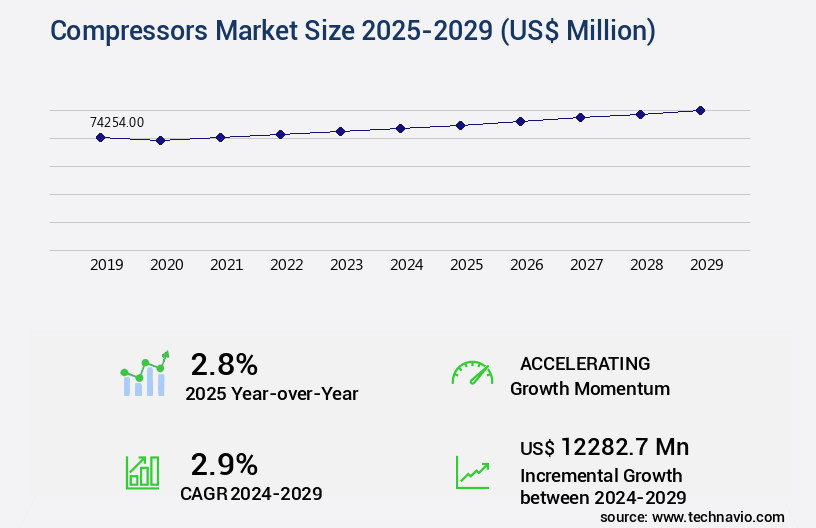
Get Key Insights on Market Forecast (PDF) Request Free Sample
How is the Compressors Market Segmented and what are the key trends of market segmentation?
The compressors industry research report provides comprehensive data (region-wise segment analysis), with forecasts and estimates in "USD million" for the period 2025-2029, as well as historical data from 2019-2023 for the following segments.
- End-user
- Oil and gas
- Process industry
- Discrete industry
- Type
- Positive displacement
- Dynamic
- Technology
- Product Type
- Medium-pressure
- Low-pressure
- Geography
- North America
- Europe
- APAC
- China
- India
- Japan
- South Korea
- South America
- Rest of World (ROW)
By End-user Insights
The oil and gas segment is estimated to witness significant growth during the forecast period.
In the dynamic and evolving oil and gas industry, compressors play a pivotal role in upstream, midstream, and downstream operations. Compressor technology is continually advancing to meet the demands of various applications, including desulfurizing and reforming in petroleum refining and transporting pressurized gas in natural gas plants. The importance of maintaining optimal pressure in oil and gas processing plants is paramount to prevent explosions and ensure worker safety. To address this need, industry suppliers offer compressors equipped with multivariable transmitters. These advanced compressors help regulate pressure fluctuations, ensuring the smooth operation of oil and gas processing facilities. Compressors are essential for the efficient handling of natural gas, particularly during storage and transport.
In liquefied natural gas (LNG) pipelines, tanks, and loading facilities, compressors ensure consistent pressure to facilitate the safe and efficient transfer of this valuable resource. Scroll compressors, rotary vane compressors, high-pressure compressors, and centrifugal compressors are among the various compressor types employed in the industry. These compressors undergo rigorous testing and optimization to improve their performance, with compressor capacity control and screw compressor efficiency being key areas of focus. Compressor lubrication systems, compressor shaft alignment, and compressor cooling methods are essential components that contribute to the overall efficiency and longevity of these machines. Moreover, advancements in oil-free compressor technology and compressor sound attenuation have led to significant improvements in energy efficiency and noise reduction.
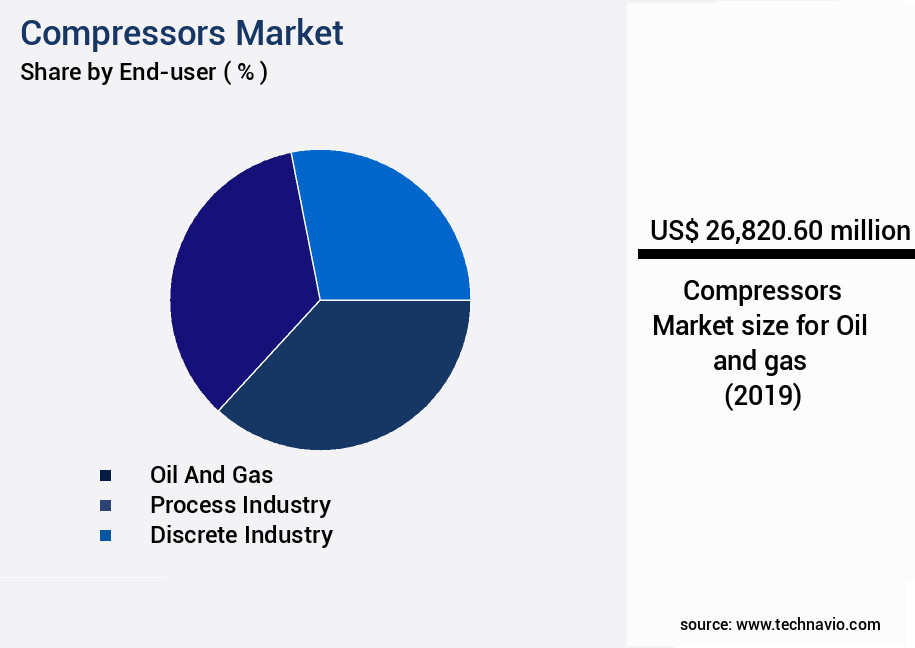
Request Free Sample
The Oil and gas segment was valued at USD 26.82 billion in 2019 and showed a gradual increase during the forecast period.
Air compressor maintenance, compressor vibration analysis, and compressor control valves are crucial aspects of compressor performance and reliability. As the industry continues to evolve, dynamic compressor types, such as positive displacement compressors, are gaining popularity due to their flexibility and adaptability to various applications. The compressor market is expected to grow significantly, with an increasing demand for compressors in the oil and gas sector, particularly in the natural gas segment. According to recent industry reports, the market for compressors in the oil and gas industry is projected to expand by 15.3% in the next five years. Additionally, the demand for compressors in the petrochemical industry is expected to grow by 11.5% during the same period.
These trends underscore the importance of compressors in the oil and gas sector and the ongoing efforts to improve their design, efficiency, and reliability.
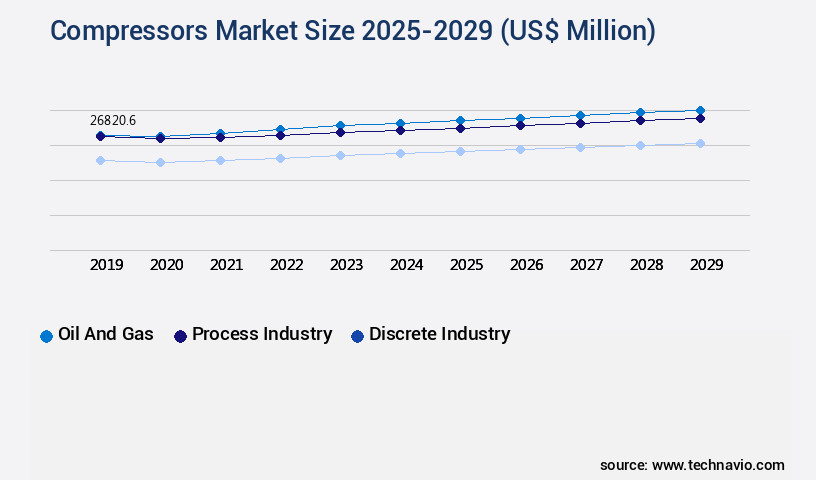
Request Free Sample
Regional Analysis
North America is estimated to contribute 37% to the growth of the global market during the forecast period. Technavio's analysts have elaborately explained the regional trends and drivers that shape the market during the forecast period.

See How Compressors Market Demand is Rising in North America Request Free Sample
The market in APAC is anticipated to experience growth due to the rising demand from the oil and gas industry. In 2023, despite low crude oil prices, APAC witnessed ongoing investments in this sector. Factors fueling this growth include the surge in manufacturing activities and the subsequent increase in energy demand. For instance, in 2023, India's Hindustan Petroleum Corp. (HPCL) announced plans to initiate its 9 million ton-a-year Barmer refinery and petrochemical project.
Furthermore, in the same year, China's Sinopec reportedly invested USD 10.5 billion in its refining and chemical business. These developments underscore the market's continuous evolution and the potential for significant expansion.
Market Dynamics
Our researchers analyzed the data with 2024 as the base year, along with the key drivers, trends, and challenges. A holistic analysis of drivers will help companies refine their marketing strategies to gain a competitive advantage.
The market encompasses various types of compressor technologies, each with unique design considerations for optimal performance. Reciprocating compressor valve design optimization plays a crucial role in enhancing efficiency and reducing wear. Centrifugal compressor impeller blade profile analysis is essential for improving flow and reducing pressure losses. Screw compressors require meticulous oil lubrication system maintenance to ensure long-term reliability and efficiency. Scroll compressors employ pressure pulsation reduction techniques to minimize noise and vibration, while axial compressor stage matching ensures balanced performance. Rotary vane compressor sealing technology advancements have led to improved efficiency and reduced emissions. Positive displacement compressor efficiency improvement strategies focus on optimizing compression ratio, reducing leakage, and minimizing heat loss.
Dynamic compressor system stability control methods mitigate surge and prevent damage to the compressor. Compressor surge protection system design and implementation are critical for safeguarding compressors against damage caused by sudden pressure drops. Oil-free compressor technology is increasingly adopted for applications requiring purity and reliability. Air compressor filtration system design best practices ensure clean air for downstream processes. Industrial compressor system energy efficiency upgrades employ advanced techniques such as variable speed compressor drive control strategies and compressor lubrication system design for optimal performance. High-pressure compressor safety system requirements mandate robust design and reliable operation. Medium-pressure compressors are commonly used in HVAC systems, while low-pressure compressors cater to specific applications requiring precise pressure control.
Comparatively, high-pressure compressors accounted for 45% of the global compressor market share in 2020, while the low-pressure segment held 35% of the market share (Market Research Reports, 2021). This trend is attributed to the growing demand for energy-efficient compressors and the increasing adoption of renewable energy sources. Turbocharger compressor design focuses on enhancing power output, while compressor sound attenuation using advanced materials ensures minimal noise pollution. Overall, the market is driven by the growing demand for energy efficiency, reliability, and advanced technology in various industries.
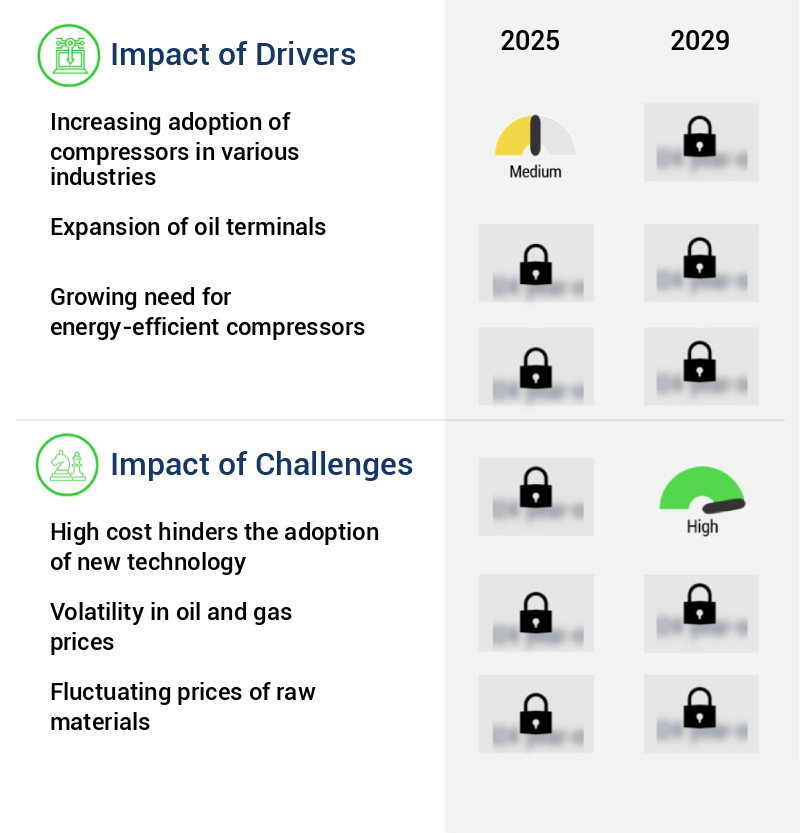
What are the key market drivers leading to the rise in the adoption of Compressors Industry?
- The significant expansion of compressor usage across diverse industries serves as the primary market catalyst.
- Compressors have gained substantial traction across various industries due to their versatility and efficiency in diverse applications. Notably, sectors such as automotive, chemical, petrochemical, and manufacturing have embraced compressors for enhancing productivity and streamlining processes involving oil and gas transfer. Compressors serve multiple purposes, including compressing gases and air, powering pneumatic tools and machinery, and generating energy for various applications. One primary reason for the widespread adoption of compressors is their capacity to boost industrial efficiency and productivity. They play a pivotal role in compressing gases and air, enabling the transfer of oil and gas from production sites to storage facilities.
- Furthermore, compressors contribute to minimizing downtime and reducing maintenance costs, making them an indispensable asset for industries. Moreover, compressors offer flexibility in handling different gases and pressures, making them an essential component in various industrial processes. Their ability to drive pneumatic tools and machinery, as well as power energy applications, underscores their versatility and importance in numerous industries. In conclusion, compressors have become an integral part of modern industrial processes, with their efficiency, productivity, and versatility making them an indispensable asset in sectors such as automotive, chemical, petrochemical, and manufacturing.
What are the market trends shaping the Compressors Industry?
- The increasing demand for oil-free compressors represents a notable market trend. Oil-free compressors are gaining popularity due to their environmental advantages and improved efficiency.
- In recent years, the market for oil-free compressors has experienced substantial expansion due to the escalating demand for contamination-free air in various industries. The necessity of maintaining stringent quality standards, particularly in the pharmaceutical, food, and electronics sectors, has fueled this growth. These industries require Class 0-certified compressors to prevent product contamination risks. Unlike traditional compressors, oil-free compressors do not utilize oil for sealing rotors or cooling compressed air. Instead, they employ cooling water circulated through the compressor casing's unique pockets.
- Oil-free compressors have gained widespread adoption in the electronics and medical devices industries, ensuring the production of high-quality, reliable products by preventing dust and dirt particles from entering product surfaces. The oil-free compressor market's continuous evolution reflects the industries' ongoing quest for superior product quality and reliability.
What challenges does the Compressors Industry face during its growth?
- The high cost of adopting new technology is a significant challenge impeding the growth of the industry. This issue, which is mandatory for businesses to address, can limit the implementation of innovative solutions and hinder progress in the sector.
- In the oil and gas sector, compressors are indispensable assets, accounting for approximately 14% of their total lifecycle cost over a decade. This expense is primarily attributed to maintenance requirements. The equipment cost represents around 12% of the overall cost, while electricity consumption accounts for a substantial 74%. The escalating manufacturing costs of compressors due to volatile raw material prices and rising labor costs have significantly impacted the industry.
- However, advancements in technology offer promising solutions. Variable frequency drives (VFD) and VFD+ are among the latest innovations, reducing electricity consumption and overall costs by enhancing compressor efficiency. These technologies are increasingly adopted in the oil and gas industry to mitigate the rising lifecycle costs of compressors.
Exclusive Customer Landscape
The compressors market forecasting report includes the adoption lifecycle of the market, covering from the innovator's stage to the laggard's stage. It focuses on adoption rates in different regions based on penetration. Furthermore, the compressors market report also includes key purchase criteria and drivers of price sensitivity to help companies evaluate and develop their market growth analysis strategies.
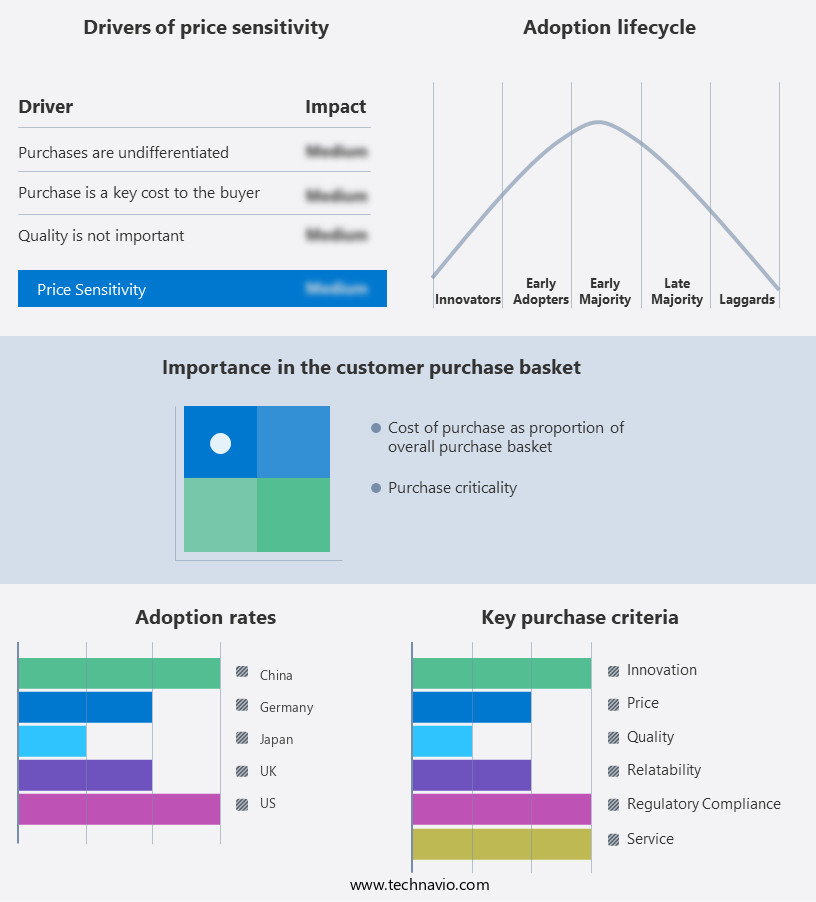
Customer Landscape of Compressors Industry
Competitive Landscape & Market Insights
Companies are implementing various strategies, such as strategic alliances, compressors market forecast, partnerships, mergers and acquisitions, geographical expansion, and product/service launches, to enhance their presence in the industry.
Atlas Copco AB - This company specializes in compressor technology, providing solutions for air and gas compression, as well as compressor parts.
The industry research and growth report includes detailed analyses of the competitive landscape of the market and information about key companies, including:
- Atlas Copco AB
- BAC Compressors
- BOGE
- Danfoss AS
- Doosan Portable Power Co.
- Elgi Equipments Ltd.
- Fusheng Precision Co. Ltd.
- Gardner Denver
- Hanbell Precise Machinery Co. Ltd.
- Hitachi Ltd.
- Indo-Air Compressors Pvt. Ltd.
- Ingersoll Rand Inc.
- KAESER KOMPRESSOREN SE
- Kaishan Compressor USA
- Kirloskar Pneumatic Co. Ltd.
- Kobe Steel Ltd.
- Siemens Energy AG
- Sulzer Ltd.
Qualitative and quantitative analysis of companies has been conducted to help clients understand the wider business environment as well as the strengths and weaknesses of key industry players. Data is qualitatively analyzed to categorize companies as pure play, category-focused, industry-focused, and diversified; it is quantitatively analyzed to categorize companies as dominant, leading, strong, tentative, and weak.
Recent Development and News in Compressors Market
- In January 2024, Gardner Denver Holdings, a leading compressor manufacturer, announced the launch of its new line of energy-efficient compressors, the "Green Series," designed to reduce carbon emissions by up to 20% compared to traditional compressors (Gardner Denver Press Release).
- In March 2024, Atlas Copco and Caterpillar signed a strategic partnership to co-develop and manufacture oil-free compressors for the industrial and mining sectors, aiming to expand their market presence and offer more comprehensive solutions to customers (Atlas Copco Press Release).
- In May 2024, Sullair, a compressor manufacturer, completed a USD 150 million investment to expand its manufacturing facility in Michigan, USA, increasing its production capacity by 50% and strengthening its position in the North American market (Sullair Press Release).
- In April 2025, the European Union passed new regulations mandating the use of energy recovery technology in compressors, effective January 2026, to reduce greenhouse gas emissions (European Union Press Release). This regulatory development is expected to drive significant investments in compressor technology upgrades across Europe.
Dive into Technavio's robust research methodology, blending expert interviews, extensive data synthesis, and validated models for unparalleled Compressors Market insights. See full methodology.
|
Market Scope
|
|
Report Coverage
|
Details
|
|
Page number
|
231
|
|
Base year
|
2024
|
|
Historic period
|
2019-2023 |
|
Forecast period
|
2025-2029
|
|
Growth momentum & CAGR
|
Accelerate at a CAGR of 2.9%
|
|
Market growth 2025-2029
|
USD 12282.7 million
|
|
Market structure
|
Fragmented
|
|
YoY growth 2024-2025(%)
|
2.8
|
|
Key countries
|
US, China, Canada, India, Germany, Brazil, Japan, Mexico, UK, and South Korea
|
|
Competitive landscape
|
Leading Companies, Market Positioning of Companies, Competitive Strategies, and Industry Risks
|
Request Free Sample
Research Analyst Overview
- In the dynamic and evolving compressor market, various compressor types continue to shape industrial processes and applications. Rotary vane compressors, known for their energy efficiency and quiet operation, are increasingly adopted due to their ability to handle a wide range of applications, from small air tools to industrial processes. High-pressure compressors, on the other hand, are essential in heavy industries, powering equipment that demands substantial pressure levels. Compressor lubrication systems play a crucial role in ensuring optimal compressor performance, with advanced technologies reducing oil consumption and improving efficiency. Axial compressor blades, a critical component, undergo continuous research to enhance aerodynamic design and reduce energy losses.
- Compressor shaft alignment and scroll compressor operation are also subjects of ongoing research, with advancements in materials and manufacturing processes improving reliability and efficiency. Refrigeration compressors and their dynamics are a significant focus in the compressor market, as they are integral to various industries, including food processing and HVAC. Industrial compressor systems, incorporating centrifugal compressor stages and compressor performance curves, are essential for large-scale industrial applications. Turbocharger compressor design and oil-free compressor technology are other areas of active research, with advancements in these areas contributing to increased efficiency and reduced emissions. Compressor sound attenuation, air compressor maintenance, and low-pressure compressors are other essential aspects of the compressor market, with ongoing research and development efforts addressing the challenges associated with these areas.
- Compressor cooling methods, compressor bearing selection, piston compressor components, air compressor filtration, centrifugal compressor impellers, and pressure ratio compressors are all subjects of continuous research and innovation. Dynamic compressor types, including positive displacement compressors, compressor capacity control, screw compressor efficiency, medium-pressure compressors, compressor control valves, reciprocating compressor design, reciprocating compressor seals, compressor vibration analysis, and dynamic compressor types, are all integral to the compressor market's ongoing evolution.
What are the Key Data Covered in this Compressors Market Research and Growth Report?
-
What is the expected growth of the Compressors Market between 2025 and 2029?
-
What segmentation does the market report cover?
-
The report segmented by End-user (Oil and gas, Process industry, and Discrete industry), Type (Positive displacement and Dynamic), Technology (Oil-lubricated and Oil-free), Product Type (Medium-pressure and Low-pressure), and Geography (APAC, North America, Europe, South America, and Middle East and Africa)
-
Which regions are analyzed in the report?
-
APAC, North America, Europe, South America, and Middle East and Africa
-
What are the key growth drivers and market challenges?
-
Who are the major players in the Compressors Market?
-
Key Companies Atlas Copco AB, BAC Compressors, BOGE, Danfoss AS, Doosan Portable Power Co., Elgi Equipments Ltd., Fusheng Precision Co. Ltd., Gardner Denver, Hanbell Precise Machinery Co. Ltd., Hitachi Ltd., Indo-Air Compressors Pvt. Ltd., Ingersoll Rand Inc., KAESER KOMPRESSOREN SE, Kaishan Compressor USA, Kirloskar Pneumatic Co. Ltd., Kobe Steel Ltd., Siemens Energy AG, and Sulzer Ltd.
Market Research Insights
- The market encompasses a diverse range of technologies and applications, with key performance metrics including compressor reliability, material selection, flow rate, fault diagnostics, and both isothermal and adiabatic processes. Compressor maintenance schedules are critical for maximizing service life and minimizing noise levels. Compressor efficiency ratings, discharge pressure, and pressure drop are essential considerations for optimizing energy consumption and reducing operational costs. Regulatory compliance and safety systems are integral components of compressor design, ensuring adherence to industry standards. Compressor design optimization and control algorithms enable improved performance and reliability, while testing procedures and application guides facilitate effective implementation.
- Compressor energy efficiency and manufacturing processes continue to evolve, driving advancements in compressor technology and innovation. For instance, compressor efficiency has increased by 10% over the past decade, while compressor power consumption has decreased by 15%. These improvements contribute significantly to the overall efficiency and sustainability of industrial processes.
We can help! Our analysts can customize this compressors market research report to meet your requirements.
Get in touch
1 Executive Summary
- 1.1 Market overview
- Executive Summary - Chart on Market Overview
- Executive Summary - Data Table on Market Overview
- Executive Summary - Chart on Global Market Characteristics
- Executive Summary - Chart on Market by Geography
- Executive Summary - Chart on Market Segmentation by End-user
- Executive Summary - Chart on Market Segmentation by Type
- Executive Summary - Chart on Market Segmentation by Technology
- Executive Summary - Chart on Market Segmentation by Product Type
- Executive Summary - Chart on Incremental Growth
- Executive Summary - Data Table on Incremental Growth
- Executive Summary - Chart on Company Market Positioning
2 Technavio Analysis
- 2.1 Analysis of price sensitivity, lifecycle, customer purchase basket, adoption rates, and purchase criteria
- Analysis of price sensitivity, lifecycle, customer purchase basket, adoption rates, and purchase criteria
- 2.2 Criticality of inputs and Factors of differentiation
- Overview on criticality of inputs and factors of differentiation
- 2.3 Factors of disruption
- Overview on factors of disruption
- 2.4 Impact of drivers and challenges
- Impact of drivers and challenges in 2024 and 2029
3 Market Landscape
- 3.1 Market ecosystem
- Parent Market
- Data Table on - Parent Market
- 3.2 Market characteristics
- Market characteristics analysis
4 Market Sizing
- 4.1 Market definition
- Offerings of companies included in the market definition
- 4.2 Market segment analysis
- 4.4 Market outlook: Forecast for 2024-2029
- Chart on Global - Market size and forecast 2024-2029 ($ million)
- Data Table on Global - Market size and forecast 2024-2029 ($ million)
- Chart on Global Market: Year-over-year growth 2024-2029 (%)
- Data Table on Global Market: Year-over-year growth 2024-2029 (%)
5 Historic Market Size
- 5.1 Global Compressors Market 2019 - 2023
- Historic Market Size - Data Table on Global Compressors Market 2019 - 2023 ($ million)
- 5.2 End-user segment analysis 2019 - 2023
- Historic Market Size - End-user Segment 2019 - 2023 ($ million)
- 5.3 Type segment analysis 2019 - 2023
- Historic Market Size - Type Segment 2019 - 2023 ($ million)
- 5.4 Technology segment analysis 2019 - 2023
- Historic Market Size - Technology Segment 2019 - 2023 ($ million)
- 5.5 Product Type segment analysis 2019 - 2023
- Historic Market Size - Product Type Segment 2019 - 2023 ($ million)
- 5.6 Geography segment analysis 2019 - 2023
- Historic Market Size - Geography Segment 2019 - 2023 ($ million)
- 5.7 Country segment analysis 2019 - 2023
- Historic Market Size - Country Segment 2019 - 2023 ($ million)
6 Qualitative Analysis
- 6.1 Impact of AI on Global Compressors Market
7 Five Forces Analysis
- 7.1 Five forces summary
- Five forces analysis - Comparison between 2024 and 2029
- 7.2 Bargaining power of buyers
- Bargaining power of buyers - Impact of key factors 2024 and 2029
- 7.3 Bargaining power of suppliers
- Bargaining power of suppliers - Impact of key factors in 2024 and 2029
- 7.4 Threat of new entrants
- Threat of new entrants - Impact of key factors in 2024 and 2029
- 7.5 Threat of substitutes
- Threat of substitutes - Impact of key factors in 2024 and 2029
- 7.6 Threat of rivalry
- Threat of rivalry - Impact of key factors in 2024 and 2029
- 7.7 Market condition
- Chart on Market condition - Five forces 2024 and 2029
8 Market Segmentation by End-user
- 8.1 Market segments
- Chart on End-user - Market share 2024-2029 (%)
- Data Table on End-user - Market share 2024-2029 (%)
- 8.2 Comparison by End-user
- Chart on Comparison by End-user
- Data Table on Comparison by End-user
- 8.3 Oil and gas - Market size and forecast 2024-2029
- Chart on Oil and gas - Market size and forecast 2024-2029 ($ million)
- Data Table on Oil and gas - Market size and forecast 2024-2029 ($ million)
- Chart on Oil and gas - Year-over-year growth 2024-2029 (%)
- Data Table on Oil and gas - Year-over-year growth 2024-2029 (%)
- 8.4 Process industry - Market size and forecast 2024-2029
- Chart on Process industry - Market size and forecast 2024-2029 ($ million)
- Data Table on Process industry - Market size and forecast 2024-2029 ($ million)
- Chart on Process industry - Year-over-year growth 2024-2029 (%)
- Data Table on Process industry - Year-over-year growth 2024-2029 (%)
- 8.5 Discrete industry - Market size and forecast 2024-2029
- Chart on Discrete industry - Market size and forecast 2024-2029 ($ million)
- Data Table on Discrete industry - Market size and forecast 2024-2029 ($ million)
- Chart on Discrete industry - Year-over-year growth 2024-2029 (%)
- Data Table on Discrete industry - Year-over-year growth 2024-2029 (%)
- 8.6 Market opportunity by End-user
- Market opportunity by End-user ($ million)
- Data Table on Market opportunity by End-user ($ million)
9 Market Segmentation by Type
- 9.1 Market segments
- Chart on Type - Market share 2024-2029 (%)
- Data Table on Type - Market share 2024-2029 (%)
- 9.2 Comparison by Type
- Chart on Comparison by Type
- Data Table on Comparison by Type
- 9.3 Positive displacement - Market size and forecast 2024-2029
- Chart on Positive displacement - Market size and forecast 2024-2029 ($ million)
- Data Table on Positive displacement - Market size and forecast 2024-2029 ($ million)
- Chart on Positive displacement - Year-over-year growth 2024-2029 (%)
- Data Table on Positive displacement - Year-over-year growth 2024-2029 (%)
- 9.4 Dynamic - Market size and forecast 2024-2029
- Chart on Dynamic - Market size and forecast 2024-2029 ($ million)
- Data Table on Dynamic - Market size and forecast 2024-2029 ($ million)
- Chart on Dynamic - Year-over-year growth 2024-2029 (%)
- Data Table on Dynamic - Year-over-year growth 2024-2029 (%)
- 9.5 Market opportunity by Type
- Market opportunity by Type ($ million)
- Data Table on Market opportunity by Type ($ million)
10 Market Segmentation by Technology
- 10.1 Market segments
- Chart on Technology - Market share 2024-2029 (%)
- Data Table on Technology - Market share 2024-2029 (%)
- 10.2 Comparison by Technology
- Chart on Comparison by Technology
- Data Table on Comparison by Technology
- 10.3 Oil-lubricated - Market size and forecast 2024-2029
- Chart on Oil-lubricated - Market size and forecast 2024-2029 ($ million)
- Data Table on Oil-lubricated - Market size and forecast 2024-2029 ($ million)
- Chart on Oil-lubricated - Year-over-year growth 2024-2029 (%)
- Data Table on Oil-lubricated - Year-over-year growth 2024-2029 (%)
- 10.4 Oil-free - Market size and forecast 2024-2029
- Chart on Oil-free - Market size and forecast 2024-2029 ($ million)
- Data Table on Oil-free - Market size and forecast 2024-2029 ($ million)
- Chart on Oil-free - Year-over-year growth 2024-2029 (%)
- Data Table on Oil-free - Year-over-year growth 2024-2029 (%)
- 10.5 Market opportunity by Technology
- Market opportunity by Technology ($ million)
- Data Table on Market opportunity by Technology ($ million)
11 Market Segmentation by Product Type
- 11.1 Market segments
- Chart on Product Type - Market share 2024-2029 (%)
- Data Table on Product Type - Market share 2024-2029 (%)
- 11.2 Comparison by Product Type
- Chart on Comparison by Product Type
- Data Table on Comparison by Product Type
- 11.3 Medium-pressure - Market size and forecast 2024-2029
- Chart on Medium-pressure - Market size and forecast 2024-2029 ($ million)
- Data Table on Medium-pressure - Market size and forecast 2024-2029 ($ million)
- Chart on Medium-pressure - Year-over-year growth 2024-2029 (%)
- Data Table on Medium-pressure - Year-over-year growth 2024-2029 (%)
- 11.4 Low-pressure - Market size and forecast 2024-2029
- Chart on Low-pressure - Market size and forecast 2024-2029 ($ million)
- Data Table on Low-pressure - Market size and forecast 2024-2029 ($ million)
- Chart on Low-pressure - Year-over-year growth 2024-2029 (%)
- Data Table on Low-pressure - Year-over-year growth 2024-2029 (%)
- 11.5 Market opportunity by Product Type
- Market opportunity by Product Type ($ million)
- Data Table on Market opportunity by Product Type ($ million)
12 Customer Landscape
- 12.1 Customer landscape overview
- Analysis of price sensitivity, lifecycle, customer purchase basket, adoption rates, and purchase criteria
13 Geographic Landscape
- 13.1 Geographic segmentation
- Chart on Market share by geography 2024-2029 (%)
- Data Table on Market share by geography 2024-2029 (%)
- 13.2 Geographic comparison
- Chart on Geographic comparison
- Data Table on Geographic comparison
- 13.3 APAC - Market size and forecast 2024-2029
- Chart on APAC - Market size and forecast 2024-2029 ($ million)
- Data Table on APAC - Market size and forecast 2024-2029 ($ million)
- Chart on APAC - Year-over-year growth 2024-2029 (%)
- Data Table on APAC - Year-over-year growth 2024-2029 (%)
- 13.4 North America - Market size and forecast 2024-2029
- Chart on North America - Market size and forecast 2024-2029 ($ million)
- Data Table on North America - Market size and forecast 2024-2029 ($ million)
- Chart on North America - Year-over-year growth 2024-2029 (%)
- Data Table on North America - Year-over-year growth 2024-2029 (%)
- 13.5 Europe - Market size and forecast 2024-2029
- Chart on Europe - Market size and forecast 2024-2029 ($ million)
- Data Table on Europe - Market size and forecast 2024-2029 ($ million)
- Chart on Europe - Year-over-year growth 2024-2029 (%)
- Data Table on Europe - Year-over-year growth 2024-2029 (%)
- 13.6 South America - Market size and forecast 2024-2029
- Chart on South America - Market size and forecast 2024-2029 ($ million)
- Data Table on South America - Market size and forecast 2024-2029 ($ million)
- Chart on South America - Year-over-year growth 2024-2029 (%)
- Data Table on South America - Year-over-year growth 2024-2029 (%)
- 13.7 Middle East and Africa - Market size and forecast 2024-2029
- Chart on Middle East and Africa - Market size and forecast 2024-2029 ($ million)
- Data Table on Middle East and Africa - Market size and forecast 2024-2029 ($ million)
- Chart on Middle East and Africa - Year-over-year growth 2024-2029 (%)
- Data Table on Middle East and Africa - Year-over-year growth 2024-2029 (%)
- 13.8 US - Market size and forecast 2024-2029
- Chart on US - Market size and forecast 2024-2029 ($ million)
- Data Table on US - Market size and forecast 2024-2029 ($ million)
- Chart on US - Year-over-year growth 2024-2029 (%)
- Data Table on US - Year-over-year growth 2024-2029 (%)
- 13.9 China - Market size and forecast 2024-2029
- Chart on China - Market size and forecast 2024-2029 ($ million)
- Data Table on China - Market size and forecast 2024-2029 ($ million)
- Chart on China - Year-over-year growth 2024-2029 (%)
- Data Table on China - Year-over-year growth 2024-2029 (%)
- 13.10 Canada - Market size and forecast 2024-2029
- Chart on Canada - Market size and forecast 2024-2029 ($ million)
- Data Table on Canada - Market size and forecast 2024-2029 ($ million)
- Chart on Canada - Year-over-year growth 2024-2029 (%)
- Data Table on Canada - Year-over-year growth 2024-2029 (%)
- 13.11 India - Market size and forecast 2024-2029
- Chart on India - Market size and forecast 2024-2029 ($ million)
- Data Table on India - Market size and forecast 2024-2029 ($ million)
- Chart on India - Year-over-year growth 2024-2029 (%)
- Data Table on India - Year-over-year growth 2024-2029 (%)
- 13.12 Germany - Market size and forecast 2024-2029
- Chart on Germany - Market size and forecast 2024-2029 ($ million)
- Data Table on Germany - Market size and forecast 2024-2029 ($ million)
- Chart on Germany - Year-over-year growth 2024-2029 (%)
- Data Table on Germany - Year-over-year growth 2024-2029 (%)
- 13.13 Japan - Market size and forecast 2024-2029
- Chart on Japan - Market size and forecast 2024-2029 ($ million)
- Data Table on Japan - Market size and forecast 2024-2029 ($ million)
- Chart on Japan - Year-over-year growth 2024-2029 (%)
- Data Table on Japan - Year-over-year growth 2024-2029 (%)
- 13.14 Mexico - Market size and forecast 2024-2029
- Chart on Mexico - Market size and forecast 2024-2029 ($ million)
- Data Table on Mexico - Market size and forecast 2024-2029 ($ million)
- Chart on Mexico - Year-over-year growth 2024-2029 (%)
- Data Table on Mexico - Year-over-year growth 2024-2029 (%)
- 13.15 Brazil - Market size and forecast 2024-2029
- Chart on Brazil - Market size and forecast 2024-2029 ($ million)
- Data Table on Brazil - Market size and forecast 2024-2029 ($ million)
- Chart on Brazil - Year-over-year growth 2024-2029 (%)
- Data Table on Brazil - Year-over-year growth 2024-2029 (%)
- 13.16 UK - Market size and forecast 2024-2029
- Chart on UK - Market size and forecast 2024-2029 ($ million)
- Data Table on UK - Market size and forecast 2024-2029 ($ million)
- Chart on UK - Year-over-year growth 2024-2029 (%)
- Data Table on UK - Year-over-year growth 2024-2029 (%)
- 13.17 South Korea - Market size and forecast 2024-2029
- Chart on South Korea - Market size and forecast 2024-2029 ($ million)
- Data Table on South Korea - Market size and forecast 2024-2029 ($ million)
- Chart on South Korea - Year-over-year growth 2024-2029 (%)
- Data Table on South Korea - Year-over-year growth 2024-2029 (%)
- 13.18 Market opportunity by geography
- Market opportunity by geography ($ million)
- Data Tables on Market opportunity by geography ($ million)
14 Drivers, Challenges, and Opportunity/Restraints
- 14.3 Impact of drivers and challenges
- Impact of drivers and challenges in 2024 and 2029
- 14.4 Market opportunities/restraints
15 Competitive Landscape
- 15.2 Competitive Landscape
- Overview on criticality of inputs and factors of differentiation
- 15.3 Landscape disruption
- Overview on factors of disruption
- 15.4 Industry risks
- Impact of key risks on business
16 Competitive Analysis
- 16.2 Company ranking index
- 16.3 Market positioning of companies
- Matrix on companies position and classification
- 16.4 Atlas Copco AB
- Atlas Copco AB - Overview
- Atlas Copco AB - Business segments
- Atlas Copco AB - Key news
- Atlas Copco AB - Key offerings
- Atlas Copco AB - Segment focus
- SWOT
- 16.5 BOGE
- BOGE - Overview
- BOGE - Product / Service
- BOGE - Key offerings
- SWOT
- 16.6 Danfoss AS
- Danfoss AS - Overview
- Danfoss AS - Product / Service
- Danfoss AS - Key offerings
- SWOT
- 16.7 Doosan Portable Power Co.
- Doosan Portable Power Co. - Overview
- Doosan Portable Power Co. - Product / Service
- Doosan Portable Power Co. - Key offerings
- SWOT
- 16.8 Elgi Equipments Ltd.
- Elgi Equipments Ltd. - Overview
- Elgi Equipments Ltd. - Business segments
- Elgi Equipments Ltd. - Key offerings
- Elgi Equipments Ltd. - Segment focus
- SWOT
- 16.9 Fusheng Precision Co. Ltd.
- Fusheng Precision Co. Ltd. - Overview
- Fusheng Precision Co. Ltd. - Product / Service
- Fusheng Precision Co. Ltd. - Key offerings
- SWOT
- 16.10 Gardner Denver
- Gardner Denver - Overview
- Gardner Denver - Product / Service
- Gardner Denver - Key offerings
- SWOT
- 16.11 Hanbell Precise Machinery Co. Ltd.
- Hanbell Precise Machinery Co. Ltd. - Overview
- Hanbell Precise Machinery Co. Ltd. - Product / Service
- Hanbell Precise Machinery Co. Ltd. - Key offerings
- SWOT
- 16.12 Hitachi Ltd.
- Hitachi Ltd. - Overview
- Hitachi Ltd. - Business segments
- Hitachi Ltd. - Key news
- Hitachi Ltd. - Key offerings
- Hitachi Ltd. - Segment focus
- SWOT
- 16.13 Indo-Air Compressors Pvt. Ltd.
- Indo-Air Compressors Pvt. Ltd. - Overview
- Indo-Air Compressors Pvt. Ltd. - Product / Service
- Indo-Air Compressors Pvt. Ltd. - Key offerings
- SWOT
- 16.14 Ingersoll Rand Inc.
- Ingersoll Rand Inc. - Overview
- Ingersoll Rand Inc. - Business segments
- Ingersoll Rand Inc. - Key offerings
- Ingersoll Rand Inc. - Segment focus
- SWOT
- 16.15 KAESER KOMPRESSOREN SE
- KAESER KOMPRESSOREN SE - Overview
- KAESER KOMPRESSOREN SE - Product / Service
- KAESER KOMPRESSOREN SE - Key offerings
- SWOT
- 16.16 Kaishan Compressor USA
- Kaishan Compressor USA - Overview
- Kaishan Compressor USA - Product / Service
- Kaishan Compressor USA - Key offerings
- SWOT
- 16.17 Siemens Energy AG
- Siemens Energy AG - Overview
- Siemens Energy AG - Business segments
- Siemens Energy AG - Key news
- Siemens Energy AG - Key offerings
- Siemens Energy AG - Segment focus
- SWOT
- 16.18 Sulzer Ltd.
- Sulzer Ltd. - Overview
- Sulzer Ltd. - Business segments
- Sulzer Ltd. - Key news
- Sulzer Ltd. - Key offerings
- Sulzer Ltd. - Segment focus
- SWOT
17 Appendix
- 17.2 Inclusions and exclusions checklist
- Inclusions checklist
- Exclusions checklist
- 17.3 Currency conversion rates for US$
- Currency conversion rates for US$
- 17.4 Research methodology
- 17.7 Validation techniques employed for market sizing
- Validation techniques employed for market sizing
- 17.9 360 degree market analysis
- 360 degree market analysis
- 17.10 List of abbreviations







![]() Get the report (PDF) sent to your email within minutes.
Get the report (PDF) sent to your email within minutes.
Complimentary full Excel data with your report purchase.